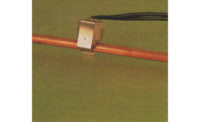The day has been really cold, and it has been below freezing for a week, when Bob gets a call from the dispatcher telling him that a customer has a very frozen heat pump outdoor coil.
Bob arrives at the house and talks to the homeowner who informs him, "The auxiliary heat light on the thermostat has been on for most of three days and the outdoor unit has a huge sheet of ice on it. I noticed that the neighbor's heat pump doesn't have ice on it."
Bob says, "That is good thinking, looking and comparing your unit to the neighbor's unit."
Bob goes outside and notices that the compressor is running, but the fan is not running. The coil has inches of ice on it. He goes to his truck and gets his tool pouch and a meter to check out the fan. He removes the cover to the compressor compartment to get to the electrical leads. He starts to shut off the disconnect when Btu Buddy appears and says, "Why don't you leave the unit on for the initial check out. If you shut it off, you may have a problem in the defrost circuit that may correct itself and you will not be able to determine what happened. The first thing to check is to see if you have power going to the fan."

Bob asks, "What do we do next?"
Btu Buddy says, "Turn the unit off at the disconnect and let's investigate one thing at a time."
Bob turns off the disconnect and removes the panel where he can touch the fan motor and says, "This motor is hot, so it must have a winding and be off because of heat or overload."
Btu Buddy suggests, "Short out that fan capacitor before you start. It may have a charge stored in it. Remember that the manufacturer wants you to use a resistor to short the capacitor to prevent excess load on it."
Bob uses a resistor and shorts across the capacitor. There is no spark and he asks Btu Buddy, "Why?"
Btu Buddy explains, "The capacitor will often discharge through the motor winding or just may not be charged. It is much safer to discharge it. It may make you hurt yourself backing up if it discharges through you. It may also hurt your meter if you try to check a charged capacitor. Capacitors can really have a jolt in them. I have seen technicians use a screwdriver to short across them and the arc would leave a mark on the screwdriver shaft."

Btu Buddy says, "Leave the unit power off and get a water hose. We will use that water to defrost the ice. The water will be at about 45 degrees F and will quickly defrost the ice. It is not solid ice; it has a lot of air in it. What will happen if you try to defrost it using the defrost cycle is that it will quickly defrost the ice close to the coil. The outside ice will then act as a shell and restrict the airflow. It is best to get the coil clean and then start it."
When the coil is defrosted using the water, Bob starts the unit. All seems well. The gas line becomes hot real quick, a good sign that the charge is good. He lets the unit run for a little while and goes inside and checks the air temperature at the registers. It is hot. The auxiliary heat is still working with the heat pump.
Bob puts all the panels in place and talks to the homeowner. She says, "Thanks for the response time. You have been out in the cold working for a while. Let me fix you a hot cup of coffee to go on to the next job."
She fixes him a cup and as he is driving off, Btu Buddy says, "Wish I was real and could have some of that coffee. It is really cold out there. The customer was nice to give you the coffee. That is a sign that you did a job that she approved of."
Bill Johnson has been active in the HVACR industry since the 1950s. He graduated in gas fuel technology and refrigeration from the Southern Technical Institute, a branch of Georgia Tech (now known as Southern Polytechnic Institute). He taught HVAC classes at Coosa Valley Vocational & Technical Institute for four years. He moved on to become service manager for Layne Trane, Charlotte, N.C. He taught for 15 years at Central Piedmont Community College, part of this time as program director. He had his own business for five years doing installation and service work. Now retired, he is the author of Practical Heating Technology and Practical Cooling Technology, and continues as a co-author of Refrigeration & Air Conditioning Technology, 5th Edition, all published by Delmar Publishers. For more information, he can be reached at 704-553-0087, 704-643-3928 (fax), or billj@carolina.rr.com.
Publication date: 12/26/2005







